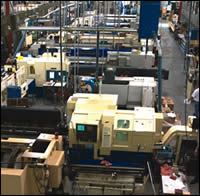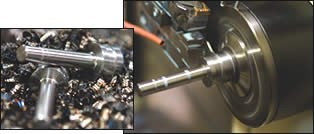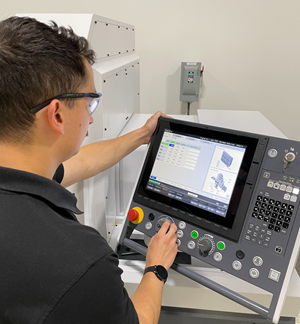Swiss-Type Turning Enables Faster, More Efficient Machining
Prince Industries, a manufacturer of precision-machined components, says it strives to exceed the needs and expectations of its customers, employees and suppliers by continuously improving virtually every aspect of its operations. Continuous improvement is not just a mantra at Prince; rather, it is the driving force behind the company’s growth.
Share




Prince Industries, a manufacturer of precision-machined components, says it strives to exceed the needs and expectations of its customers, employees and suppliers by continuously improving virtually every aspect of its operations. Continuous improvement is not just a mantra at Prince; rather, it is the driving force behind the company’s growth.
In early 2006, the continuous improvement team examined the process for machining an engine brake component. The procedure already produced the part profitably with a 32-micron finish and 0.0005-inch perpendicularity on both faces to the OD of the part.
“We knew that in theory, it could be manufactured faster and more efficiently,” explains Mark Paluch, vice president of manufacturing at Prince. “It was an issue of cost and capability.”
Ed Miller Sr. founded Prince in 1959 with one handsaw machine and a Brown and Sharpe lathe. Since then, the company has grown to a global enterprise with facilities in the United States and Shanghai, China. High-volume machining, turning, centerless grinding and honing are areas of particular expertise.
To develop a new process to machine the engine brake component more efficiently, the company consulted a number of leading machine tool manufacturers and distributors. Under the old method, the brake component was turned from 4140 steel on a bar-fed, twin-spindle, single-turret lathe. The part has a length-to-width ratio of less than 5:1, and initial process reviews led the company to consider a more capable gang-tooled lathe.
During the review, Rem Sales Regional Manager Dan Murphy and Application Engineering Manager Steve Tragarz introduced a Tsugami BU38SY Swiss-turn as a potential solution. The duo agreed that this machine was a good fit for several reasons. For one, the BU38SY offered the possibility to produce the part complete from barstock. In addition, the sliding-headstock machine could remove inaccuracies that may result from workpiece deflection on the type of gang-tooled lathe the shop might have considered.
“We are by no means strangers to Swiss-turns,” Mr. Paluch says. “Given the size and geometry of the part, however, we didn’t even think that it was a Swiss application.”
Before the part could be successfully processed on a sliding-headstock lathe, Prince would need to address several issues. First, two parts needed to be turned complete from barstock with different stem lengths. Also critical was increasing tool life and eliminating the need for hard facing and hole deburring after heat treating. Mr. Tragarz and the Rem Sales team felt comfortable with those requirements, but they realized that the project’s success also hinged on a dramatically reduced cycle time.
“To improve the cycle time, the Swiss-turn would have to remove a substantial amount of relatively hard material quickly,” Mr. Tragarz explains. “This is something that Swiss-turns are not typically known for.”
However, Mr. Tragarz was confident that the lathe’s pinch-turn capability made it the right choice for the project. Designed with heavy cutting in mind, the Tsugami BU38SY can accommodate diameters as large as 11/2 inches. The Swiss-turn also features a 15-hp main spindle; a 10-hp subspindle; an eight-station rear turret; a Y axis; and milling on both the front gang slide and the rear turret.
Mr. Murphy developed the process, provided the time estimates and purchased the original tooling. Application Engineer Scott Hauser joined the team to execute the programming and prove out the process. The keystone and first step of the project was creating a program that could turn the two parts with unique geometries mentioned above in one setup. Mr. Hauser began by writing a program based on variables that use a custom macro feature in the Tsugami-Fanuc CNC.
“We knew it was possible to change-over from one part to the next within the family,” Mr. Hauser says. “We could accomplish this by changing one variable and the identification roll on the roll stamp. The machine operator would then be able to change-over in just a few minutes.”
The team began with the goal of developing a stable tooling process after meeting with Jim Campbell, Prince Industries’ project leader, and tooling experts from Sandvik Coromant who were willing to share their experience with producing these parts. The new process would extend tooling life beyond the approximately 60 pieces that could be cut with the roughing tool and the 160 pieces that could be cut with the finishing tool. Mr. Murphy recommended increasing the depth of cut to eliminate the multiple roughing passes. Using the stability of the Tsugami BU38SY and its 15-hp main spindle, the team increased the depth of cut to 0.270 inch at 500 surface feet per minute with the front gang slide. Consequently, they were able to consistently and efficiently remove material from the part, producing that familiar popcorn sound of “big blue chips hitting the glass.” A maximum 0.0003-inch perpendicularity from the face to the OD was maintained using unground, cold-drawn barstock.
“In doing so, Prince Industries was able to achieve 470 linear inches of cut and 210 pieces before changing the roughing tool,” Mr. Murphy says. “Finishing tool life was extended to 782 linear inches of cut or 350 pieces—an improvement of 250 percent on the roughing tool and 194 percent on the finishing tool. All of this was accomplished while maintaining a 32-micron finish on the face in both the main and subspindles.”
The Tsugami BU38SY’s milling units in the front gang slide and back turret further reduced cycle time, the manufacturer says. They enable simultaneously drilling and deburring a cross hole in the main and subspindle during subsequent operations, thus removing the need for hard facing and deburring after heat treating. While the team realized early on that the Swiss-turn could quickly remove large amounts of metal, everyone was surprised when the final process generated enough chips to fill a 55-gallon drum every 4 hours.
Related Content
Digitalization and Done-In-One Reign Supreme at BIEMH 2024
European manufacturers may have a different balance of markets than their U.S. counterparts, but the practical challenges they must overcome are often similar — as are the solutions.
Read MoreGrob Mill-Turn Machining Center Provides Flexible Performance
The G550T mill-turn universal machining center offers optimized milling and turning performance for a broad range of part materials in one setup.
Read MoreSwiss-Type Control Uses CNC Data to Improve Efficiency
Advanced controls for Swiss-type CNC lathes uses machine data to prevent tool collisions, saving setup time and scrap costs.
Read MoreInverting Turning and Five-Axis Milling at Famar
Automation is only the tip of the iceberg for Famar, which also provides multitasking options for its vertical lathes and horizontal five-axis machine tools.
Read MoreRead Next
Setting Up the Building Blocks for a Digital Factory
Woodward Inc. spent over a year developing an API to connect machines to its digital factory. Caron Engineering’s MiConnect has cut most of this process while also granting the shop greater access to machine information.
Read MoreRegistration Now Open for the Precision Machining Technology Show (PMTS) 2025
The precision machining industry’s premier event returns to Cleveland, OH, April 1-3.
Read MoreBuilding Out a Foundation for Student Machinists
Autodesk and Haas have teamed up to produce an introductory course for students that covers the basics of CAD, CAM and CNC while providing them with a portfolio part.
Read More





























.jpg;maxWidth=300;quality=90)







